
A schooner is a type of sailing vessel defined by its rig: fore-and-aft rigged on all of 2 or more masts and, in the case of a 2 masted schooner, the foremast generally being shorter than the mainmast. A common variant, the topsail schooner also has a square topsail on the foremast, to which may be added a topgallant and other square sails, but not a fore course, as that would make the vessel a brigantine. Many schooners are gaff-rigged, but other examples include Bermuda rig and the staysail schooner.

Mystic Seaport Museum or Mystic Seaport: The Museum of America and the Sea in Mystic, Connecticut is the largest maritime museum in the United States. It is notable for its collection of sailing ships and boats and for the re-creation of the crafts and fabric of an entire 19th-century seafaring village. It consists of more than 60 historic buildings, most of them rare commercial structures moved to the 19-acre (0.077 km2) site and meticulously restored.

Rhode Island Sound is a strait of water off the coast of the U.S. state of Rhode Island at the mouth of Narragansett Bay. It forms the eastern extension of Block Island Sound and opens out the Atlantic Ocean between Block Island and Martha's Vineyard.
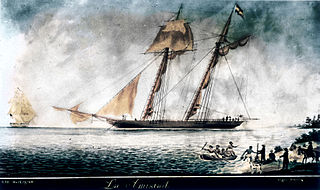
La Amistad was a 19th-century two-masted schooner, owned by a Spaniard living in Cuba. It became renowned in July 1839 for a slave revolt by Mende captives, who had been captured by Portuguese slave hunters in Sierra Leone and brought to Cuba. Two Spanish plantation owners, Don José Ruiz and Don Pedro Montes, bought 53 captives in Havana, Cuba and were transporting them on the ship to their plantations near Puerto Príncipe. The revolt began after the schooner's cook jokingly told the slaves that they were to be "killed, salted, and cooked". Sengbe Pieh, a Mende man, also known as Joseph Cinqué, unshackled himself and the others on the third day and started the revolt. They took control of the ship, killing the captain and the cook. In the melee, three Africans were also killed.

NOAA Ship John N. Cobb was a National Oceanic and Atmospheric Administration research vessel in commission from 1970 to 2008. She was named for John Nathan Cobb and was the oldest commissioned ship in the NOAA fleet when she was decommissioned, having previously served in the United States Department of the Interior′s Fish and Wildlife Service from 1950 to 1956 and in the United States Fish and Wildlife Service′s Bureau of Commercial Fisheries from 1956 to 1970 as R/V John N. Cobb.

Te Vega is a two-masted, gaff-rigged auxiliary schooner. Originally launched as the Etak, she was designed by New York naval architects Cox & Stevens in 1929 for American businessman Walter Graeme Ladd and his wife, Catherine ("Kate") Everit Macy Ladd. Etak was built at the Friedrich Krupp Germaniawerft shipyard in Kiel, Germany, and launched in 1930. During World War II she served the US Navy as Juniata (IX-77). She is among the largest steel-hulled schooners afloat.

The Black Douglas is a three-masted staysail auxiliary schooner built for Robert C. Roebling at the Bath Iron Works of Bath, Maine, and launched on 9 June 1930. Designed by renowned New York City naval architects H.J. Gielow & Co., she is one of the largest steel-hulled schooners ever built.

Thomas W. Lawson was a seven-masted, steel-hulled schooner built for the Pacific trade, but used primarily to haul coal and oil along the East Coast of the United States. Named for copper baron Thomas W. Lawson, a Boston millionaire, stock-broker, book author, and president of the Boston Bay State Gas Co., she was launched in 1902 as the largest schooner and largest sailing vessel without an auxiliary engine ever built.

Western Union is a historic schooner located in Key West, Florida, United States. She is berthed at the Key West Bight at 202 William Street. Western Union is the last surviving authentic working tall ship built in Florida. On May 16, 1984, Western Union was added to the US National Register of Historic Places. She is also the official flagship of the State of Florida and the flagship of the city of Key West.
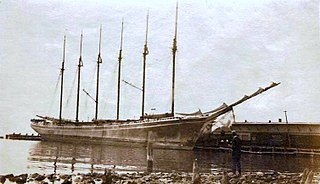
Wyoming was a wooden six-masted schooner built and completed in 1909 by the firm of Percy & Small in Bath, Maine. With a length of 450 ft (140 m) from jib-boom tip to spanker boom tip, Wyoming was the largest known wooden ship ever built.
Abels Shipbuilders Ltd was a ship and boat builder in Bristol, England. In addition to boat building, the company branched out into architectural sculptures, tidal energy and marine restoration, but closed in 2016.
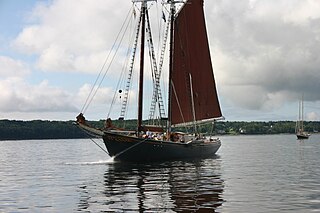
Roseway is a wooden gaff-rigged schooner launched on 24 November 1925 in Essex, Massachusetts. She is currently operated by World Ocean School, a non-profit educational organization based in Camden, Maine, and is normally operated out of Boston, Massachusetts and Saint Croix, U.S. Virgin Islands. She was designated a National Historic Landmark in 1997 as the only known surviving example of a fishing schooner built specifically with racing competition as an objective.

The Virginia Institute of Marine Science (VIMS) is one of the largest marine research and education centers in the United States. Founded in 1940, VIMS is unique among marine science institutions in its legal mandate to provide research, education, and advisory service to government, citizens, and industry. Funding for VIMS comes from the Commonwealth of Virginia, grants and contracts from federal and state agencies, and private giving. The School of Marine Science (SMS) at VIMS is the graduate school in marine science for the College of William & Mary. Offering both M.S. and Ph.D. degrees in marine science, the school has 57 faculty members, an enrollment of 80-100 students, and includes 4 academic departments. VIMS' main campus is located in Gloucester Point, Virginia.

Virginia is a wooden schooner that is a modern replica of an early twentieth century pilot vessel of the same name. She conducts educational programs and passenger trips along the Eastern Seaboard of the United States and Canada, and in the Caribbean.

Australia is a coasting schooner located at Mystic Seaport in Mystic, Connecticut, United States. Australia was built in 1862 in Great South Bay, Long Island, New York and was originally named Alma. Australia was designed to carry freight and to be able to traverse shallow water. Australia was used as a Confederate blockade runner during the American Civil War until she was captured by Union warships and sold at auction. Mystic Seaport acquired her in 1951 for use as a training vessel. In 1962 Australia was hauled out for restoration but damage to the hull was deemed too extensive and the vessel was permanently beached. Australia is now housed in a shed and used as an exhibit on ship construction.
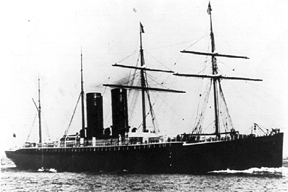
SS Oregon was a record breaking British passenger liner that won the Blue Riband for the Guion Line as the fastest liner on the Atlantic in 1884. She was sold to the Cunard Line after a few voyages and continued to improve her passage times for her new owner. In 1885, Oregon was chartered to the Royal Navy as an auxiliary cruiser, and her success in this role resulted in the Admiralty subsidizing suitable ships for quick conversion in the event of a crisis. She returned to Cunard service in November 1885 and four months later collided with a schooner while approaching New York. All persons on board were rescued before Oregon sank. Her wreck, 18 miles east of Long Island, remains a popular diving site.
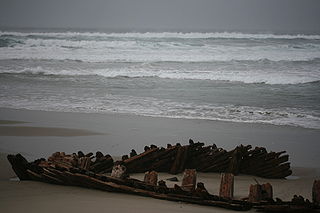
Sibyl Marston was a wooden schooner cargo ship built by W.A. Boole & Sons of Oakland, California and belonging to the Sibyl Marston Co. Sibyl Marston sank off the coast of Lompoc, California on 12 January 1909.

The Carrier Dove was a 4-masted schooner built by the Hall Brothers in Port Blakely in 1890. She worked in the West coast lumber trade and in fishing.

The Shearwater is an 81.5-foot (24.8 m) wooden schooner docked in Lower Manhattan in New York City in the U.S. state of New York. The schooner was designed by Theodore Donald Wells and built by the Rice Brothers Corporation in East Boothbay, Maine in 1929. During World War II, it was requisitioned into the United States Coast Guard to patrol for German U-boats. The Shearwater completed a circumnavigation of the world in the early-1980s and later worked as a research laboratory for the University of Pennsylvania's Institute of Environmental Medicine. Docked about 200 yards (180 m) west of the site of the World Trade Center, it is operated by Manhattan by Sail, which gives 90-minute-long tours of New York Harbor, and is licensed to carry 48 passengers. The schooner was listed on the National Register of Historic Places in 2009.

Wendameen is a historic schooner normally berthed at the Maine State Pier on Commercial Street in Portland, Maine. She is a two-masted auxiliary rigged schooner, built in 1912 by the noted naval architect John G. Alden. She is now owned and operated by the Portland Schooner Company, which offers sailing tours of Casco Bay, using Wendameen and Bagheera. Wendameen was listed on the National Register of Historic Places in 1992.



















